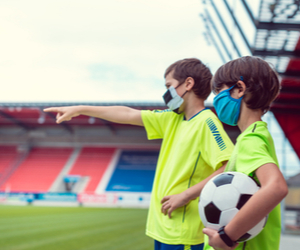
What Kind of Impact are Masks Having on Youth Sports?
Summer may be ending but youth sports continue to reopen. The cooler weather will bring more sports and see many moving indoors. Now that there’s been some time to feel things out, we want to look at what kind of impact is wearing a mask having on youth sports and the participants? What masks work best for athletics? And how are different communities approaching mask use in this evolving field of play?
The data is still coming around what, when, and how to best utilize masks in youth sports. There are a lot of variables that make tracking impact difficult. But what we are seeing is that the use of masks has a limited impact on youth sports participants. In general, regions are following state and federal guidelines and, as a result, continue to reopen with more teams getting to play in more sports across the country.
Before getting into the impacts, recall why masks are in use: to protect the user from infection and from unwittingly transmitting virus particles. Especially important in youth sports is that “recent data suggests that the latter benefits may be key to reducing the community spread of Covid-19(3,4).”(REF: https://www.peakendurancesport.com/endurance-injuries-and-health/endurance-health-and-lifestyle/face-mask-use-sport-pros-cons-athletes/). The nature of the virus is such that anyone could be transmitting unawares.
How wearing a masks may or may not impact physical activity
Sports that require little exertion make it easier to wear a mask and maintain the 6ft standard for social distance. Reducing transmission is the key and in sports such as golf or baseball, there’s no evidence of impact on performance.
This changes when it comes to high-intensity sports, such as cross-country, soccer, basketball, and football. Not only does wearing a mask reduce the ability to take in oxygen and causes the user to recirculate carbon dioxide, it may make kids feel dizzy, light-headed, or not perform at their best.
Though the research in this realm is so new the ink hasn’t even dried on the most recent reports, the general consensus is that no athlete should be wearing a mask if they are participating in any high-exertion sport. The decision is up to coaches and parents but it is worth noting the CDC guidelines. Specific to masks and high-exertion sports, they (REF: https://www.cdc.gov/coronavirus/2019-ncov/) suggests people “engaged in high intensity activities, like running, may not be able to wear a mask if it causes difficulty breathing…If unable to wear a mask, consider conducting the activity in a location with greater ventilation and air exchange (for instance, outdoors versus indoors) and where it is possible to maintain physical distance from others…For youth athletes, parents, coaches, and sports administrators should decide if the kids need to wear a mask.”
How different regions approach masks use
Each region is learning as they go how best to implement the masks use — whether it is for practices or games. In Pennsylvania, the Pennsylvania Interscholastic Athletic Association (PIAA) requires athletes to wear masks “when on the sidelines, in the dugout, etc. and anytime 6 feet of social distancing is not possible.” In short, if you aren’t on the field or court, wearing a masks is recommended and easy to manage.(REF: https://cumberlink.com/sports/high-school/athletes-dont-need-masks-while-working-out-under-piaa-mask-wearing-update/article_11b57c1e-462f-591b-998f-1d8ec0ad7097.html) This is, also, in-line with CDC recommendations and regional guidelines. and common best practice throughout the United States.
Before shutdown this past spring, an outbreak was a result, in part, due to a sectionals basketball championship game in Decatur County, IN. This was before there was widespread mask use and likely no plan in place for indoor gatherings. As more sports move indoors for the fall and winter months, having a strong plan in place will be critical for community safety.
Some regions are limiting attendance of events, but requiring mask use and distancing for those that do attend as spectators. And, as much as reasonable, events continue to take place outdoors.
Best masks for the game
No matter where you or your team land on when to wear masks, you want to make sure your kids have the best masks for the game. Cloth is the gold standard for youth masks and you can find them at your local retailer or online.
Keep fit in mind when choosing as the fit needs to be comfortable while keeping a good seal around the face. Disposable masks, most commonly referred to as surgical masks, are designed to protect others from you and have a low threshold for blocking the small particles associated with COVID-19.(REF: https://www.npr.org/sections/goatsandsoda/2020/07/01/880621610/a-users-guide-to-masks-what-s-best-at-protecting-others-and-yourself). If you aren’t in a medical setting then the experts recommend cloth masks for optimal protection.(REF: https://www.hopkinsmedicine.org/health/conditions-and-diseases/coronavirus/coronavirus-face-masks-what-you-need-to-know) Cloth isn’t limited to cotton. Protection comes with the tightness of the weave and the number of layers, regardless of if it is made of cotton, nylon, polypropylene, or spandex.
There are athlete-specific masks available, made of quick-dry material — polyester, nylon, spandex — similar to athletic clothing. Under Amour’s UA Sportsmask ticks all the boxes with its breathability, fit, washability, and anti-microbial treatment.
Choosing a mask designed for sports is the best route to go when deciding how to prepare so kids can perform. This is all new territory and, as mentioned, the research is still quite fresh around if, when, and what kinds of masks should be used for sports. A strong plan and community awareness of expectations at events should be in place. Wherever you land on mask use in general, the use of masks in youth sports during the ongoing pandemic is the best way to ensure youth sports keep going.
TeamSnap recommends you always check with your coach or sports organization administration regarding policies and procedures that may be specific to your team.
Kendall Ruth is a writer, photographer, and strategist finding the best ways to tell resonating, re-humanizing stories. You can find him at kendallruth.com, kicking the soccer ball with his kids, or out on a long trail run.

